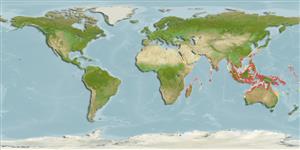Bivalvia |
Myida |
Pholadidae
Environment: milieu / climate zone / गहराई सीमा / distribution range
पारिस्थितिकी
; गहराई सीमा 0 - 20 m (संदर्भ 348). Tropical
Indo-West Pacific: from Pakistan to the Philippines and Indonesia; north to South China Sea and south to Queensland.
Length at first maturity / आकार / Weight / Age
परिपक्व अवधि: Lm ? range ? - ? cm Max length : 12.0 cm SHL पुल्लिंग / अलिंग; (संदर्भ 348); common length : 9.0 cm SHL पुल्लिंग / अलिंग; (संदर्भ 348)
Collected by divers using an iron or wooden paddle-shaped implement or bare hands to dig the animals from their burrows (Ref. 348). Minimum depth range from Ref. 75831. Found in intertidal areas in clay (Ref. 75831).
Life cycle and mating behavior
परिपक्व अवधि | पुनरुत्पत्ति | मछलीऔ का अंडे देना | Eggs | Fecundity | Larvae
Members of the class Bivalvia are mostly gonochoric, some are protandric hermaphrodites. Life cycle: Embryos develop into free-swimming trocophore larvae, succeeded by the bivalve veliger, resembling a miniature clam.
Poutiers, J.M. 1998 Bivalves. Acephala, Lamellibranchia, Pelecypoda. p. 123-362. In Carpenter, K. E. and V. H. Niem. 1998. FAO species identification guide for fishery purposes. The living marine resources of the Western Central Pacific. Volume 1. Seaweeds, corals, bivalves, and gastropods. Rome, FAO. (संदर्भ 348)
IUCN Red List Status
(संदर्भ 130435: Version 2025-1)
CITES status (संदर्भ 108899)
Not Evaluated
CMS (संदर्भ 116361)
Not Evaluated
Threat to humans
Harmless
Human uses
| FishSource |
साधन
अधिक जानकारी
Trophic EcologyFood items (preys)
संघटक आहार
आहार खपत
परभक्षी
Life cycleपुनरुत्पत्तिपरिपक्व अवधिFecundityमछलीऔ का अंडे देनाEggsEgg developmentLarvae PhysiologyOxygen consumption
Human RelatedStamps, coins, misc.
इंटरनेट स्रोत
Estimates based on models
Preferred temperature
(Ref.
115969): 26 - 29.3, mean 28.6 (based on 2536 cells).
लौटाव
ऊंचा, न्यूनतम जनसंख्या दुगनी समय अवलागत 15 महीने। (K=0.91).
Fishing Vulnerability
Low vulnerability (10 of 100).
Price category
Unknown.
